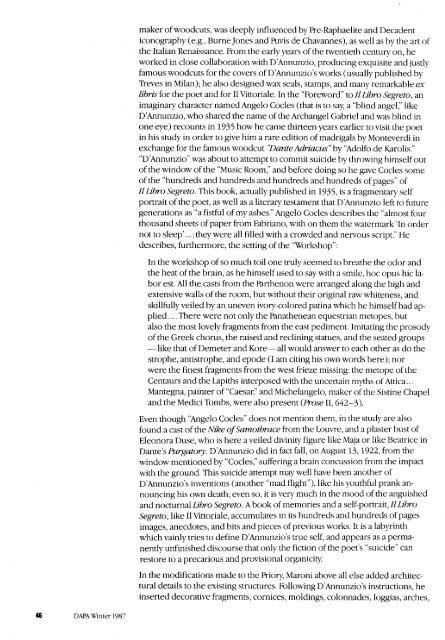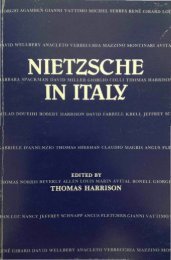The Journal of Decorative and Propaganda Arts - UCLA Department ...
The Journal of Decorative and Propaganda Arts - UCLA Department ...
The Journal of Decorative and Propaganda Arts - UCLA Department ...
Create successful ePaper yourself
Turn your PDF publications into a flip-book with our unique Google optimized e-Paper software.
DAPAWinter 1987<br />
maker <strong>of</strong> woodcus, was deeply influenced by Pre-Raphaelite <strong>and</strong> Decadent<br />
iconography (e.g., BurneJones <strong>and</strong> Rrvis de Chavannes), as well as by the art <strong>of</strong><br />
the Italian Renaissance. From the earlyyears <strong>of</strong> the twentieth century on, he<br />
worked in close collaboration with D'Annunzio, producing exquisite <strong>and</strong> justly<br />
famous woodcuts for the covers <strong>of</strong> D'Annunzio's works (usually published by<br />
Treves in Milan); he also designed wax seals, stamps, <strong>and</strong> many remarkable ex<br />
libris for the poet <strong>and</strong> for Il Vittoriale. In the "Foreword" to Il Libro Segreto, an<br />
imaginary character namedAngelo Cocles (that is ro say, a "blind angel," like<br />
D'Annunzio, who shared the name <strong>of</strong> the Archangel Gabriel <strong>and</strong> was blind in<br />
one eye) recounts in1935 how he came thirteen years earlier to visit the poet<br />
in his study in order to give him a rare edition <strong>of</strong> madrigals by Monteverdi in<br />
exchange for the famous woodcut "Dante Adrinats" bl,'Adolfo de Karolis."<br />
"D'Annunzio"<br />
was about to attempt to commit suicide by throwing himself out<br />
<strong>of</strong> the window <strong>of</strong> the "Music Room," <strong>and</strong> before doing so he gave Cocles some<br />
<strong>of</strong>the "hundreds <strong>and</strong> hundreds <strong>and</strong> hundreds <strong>and</strong> hundreds <strong>of</strong>pages" <strong>of</strong><br />
Il Libro Segreto. This book, actually published in 1935, is a fragmentary self<br />
portrait <strong>of</strong> the poet, as well as a literary testament that D'Annunzio left to future<br />
generations as "a fistful <strong>of</strong> my ashes." Angelo Cocles describes the "almost four<br />
thous<strong>and</strong> sheets <strong>of</strong> paper from Fabriano, with on them the watermark'In order<br />
not to sleep'. . . ;they were all filled with a crowded <strong>and</strong> nervous script." He<br />
describes, furthermore, the setting <strong>of</strong> the "\Torkshop":<br />
In the workshop <strong>of</strong> so much toil one truly seemed to breathe the odor <strong>and</strong><br />
the heat <strong>of</strong> the brain, as he himself used to saywith a smile, hoc opus hic labor<br />
est. all the casts from the Parthenon were arranged along the high <strong>and</strong><br />
extensive walls <strong>of</strong> the room, but without their original raw whiteness, <strong>and</strong><br />
skillfullyveiled by an uneven ivory-colored patinawhich he himself had applied....<br />
<strong>The</strong>re were not only the Panathenean equestrian metopes, but<br />
also the most lovely fragments from the east pediment. Imitating the prosody<br />
<strong>of</strong> the Greek chorus, the raised <strong>and</strong> reclining statues, <strong>and</strong> the seated groups<br />
-like that <strong>of</strong> Demeter <strong>and</strong> Kore-all would answer to each other as do the<br />
strophe, antistrophe, <strong>and</strong> epode (I am citing his own words here); nor<br />
were the finest fragments from the west frieze missing: the metope <strong>of</strong> the<br />
Centaurs <strong>and</strong> the Lapiths interposed with the uncertain m)'ths <strong>of</strong> Attica. . .<br />
Mantegna, painter <strong>of</strong> "Caesar,"<br />
<strong>and</strong> Michelangelo, maker <strong>of</strong> the Sistine Chapel<br />
<strong>and</strong> the Medici Tombs, were also present (Plosell,642-3).<br />
Even though 'Angelo Cocles" does not mention them, in the study are also<br />
found a cast <strong>of</strong> theNrke <strong>of</strong> Samotbrace from the Louvre, <strong>and</strong> a plaster bust <strong>of</strong><br />
Eleonora Duse, who is here a veiled divinity figure like Maja or like Beatrice in<br />
Dante's Pttrgatory.D'Annunzio did in fact fall, on August L3,1922, from the<br />
window mentioned by "Cocles," suffering a brain concussion from the impact<br />
with the ground. This suicide attempt maywell have been another <strong>of</strong><br />
D'Annunzio's inventions (another "mad flight"), like his youthful prank announcing<br />
his own death; even so, it is very much in the mood <strong>of</strong> the anguished<br />
<strong>and</strong> nocturnal Libro Segreto. A book <strong>of</strong> memories <strong>and</strong> a self-portrait, Il Libro<br />
Segreto,like Il Vittoriale, accumulates in its hundreds <strong>and</strong> hundreds <strong>of</strong> pages<br />
images, anecdotes, <strong>and</strong> bits <strong>and</strong> pieces <strong>of</strong> previous works. It is a labyrinth<br />
which vainly tries to define D'Annunzio's true self, <strong>and</strong> appears as a permanently<br />
unfinished discourse that only the fiction <strong>of</strong> the poet's "suicide" can<br />
restore to a precarious <strong>and</strong> provisional organicity.<br />
In the modifications made to the Priory Maroni above all else added architectural<br />
details to the existing structures. Following D'Annunzio's instructions, he<br />
inserted decorative fragments, cornices, moldings, colonnades, loggias, arches,




